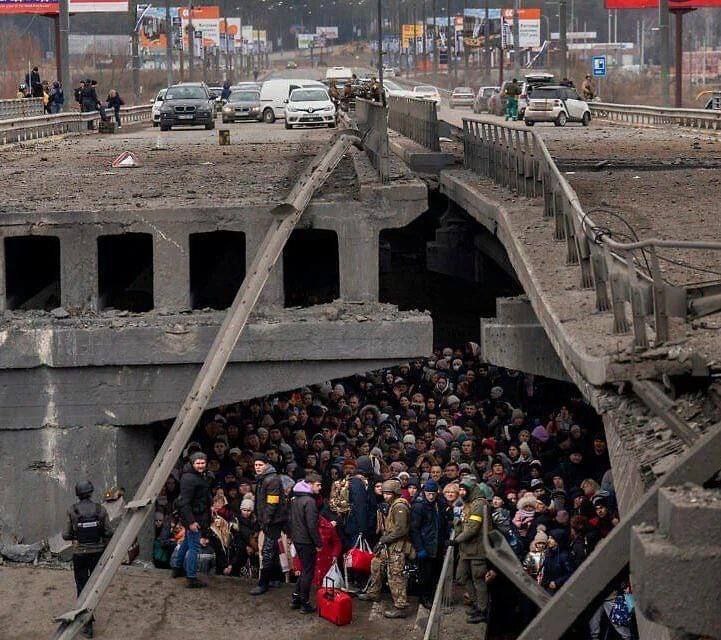Ukraine & Russia Timeline
A crowd takes shelter under a bridge, looking over their shoulders with solemn expressions. Since Feb. 24, 2022, Russian bombs have rained down on Ukraine, destroying homes and taking lives.
Ukraine and Russia: A Timeline
Russia’s recent war against Ukraine has left thousands dead and people around the world wondering, “Why?” A brief look at recent history reveals that the answer is more complex than it may seem.
1991: The Soviet Union collapses.
In early December of 1991, the leaders of three Soviet Socialist Republics – Belarus, Russia and Ukraine – signed an agreement to dissolve the Soviet Union (USSR). Weeks later, on Dec. 25, 1991, Mikhail Gorbachev, then leader of the USSR, resigned and the USSR collapsed, relinquishing totalitarian control over its citizens. The fifteen republics that comprised the USSR, including Ukraine, declared their sovereignty from the USSR.
Like its counterparts, as a newly independent country, Ukraine struggled with supply chain issues, building a military and formatting its new system of governance. To combat these issues, Ukraine and 11 of the other former Soviet republics formed the Commonwealth of Independent States (CIS) – an organization that facilitates the movement of goods, services, labor and capital between the countries.
1994: The Budapest Memorandum is signed.
After the Soviet Union fell, its extensive nuclear arsenal was inherited by four newly independent states: Ukraine, Kazakhstan, Belarus and Russia. The United States did not want any new nuclear states to emerge from the collapse of the USSR, so the Budapest Memorandum was created. This agreement was signed on Dec. 5, 1994 by the United States, the United Kingdom and the Russian Federation, assuring Ukraine that they were recognised as a sovereign state with their existing borders. Ukraine was also promised that threats or violence would not be used against them. Although Ukraine was hesitant to disarm themselves, they agreed and turned over their nuclear arsenal (which was the third largest in the world) to Russia to be dismantled.
2004: Fraudulent presidential election revealed.
Viktor Yanukovych, a pro-Russian candidate, was elected president in the fraudulent 2004 Ukrainian presidential election. This sparked protests from supporters of his opponent, pro-Western candidate Viktor Yushchenko. This movement was later referred to as the Orange Revolution.
On December 3, 2004, The Supreme Court ruled that the election was invalid and ordered a runoff. Viktor Yushchenko earned 52% of the votes; although Yushchenko legitimately won the election, he and Yanukovich continued to vie for influence throughout his presidency.
2010: Viktor Yanukovych returns to power.
By 2010, Yushchenko had lost his popularity among Ukrainian citizens. He was replaced by the winner of the 2010 election, formerly-deposed Yanukovych. Months after his election, Yanukovych made a deal with Russia to extend their use of Ukraine’s port in Sevastopol from 2017 to 2042. In return, Ukraine got a reduced price on Russian natural gas. Yanukovych then abandoned Ukraine’s plans to join the North Atlantic Treaty Organization (NATO), which furthered his relationship with Russia.
2013-14: The Euromaidan protests.
In 2013, President Yanukovych rejected a deal from the European Union (EU) that was widely popular, and instead took a large amount of aid from Russia. Ukrainian citizens retaliated by gathering on Kyiv’s Independence Square in the largest wave of mass protests since Ukraine’s independence. These demonstrations lasted into 2014 and although protestors were subjected to unlawful arrests, kidnapping and assault, they only grew in numbers. These protests would later be cited as Euromaidan, after the nickname of Kyiv’s Independence Square, Maidan, and the desire to become closer to Europe.
Russia took advantage of the unrest by annexing Crimea, a peninsula in the Black Sea that was transferred to Ukraine in 1954. Russia then shifted focus to the Donbas Region of eastern Ukraine where separatists had taken up arms against the Ukrainian government. On Feb. 12, 2015, the Minsk II Agreement was signed by representatives from Ukraine, Germany, France and Russia. These accords were supposed to initiate a ceasefire, withdraw heavy weapons from the front line, release prisoners of war, begin constitutional reform in Ukraine granting self-government to certain areas of Donbas and restore control of the state border to the Ukrainian government. The agreement was never fully implemented, although a ceasefire did take place; while the armed confrontation stopped, the conflict never did.
2019: Volodymyr Zelenskyy is elected President.
In March of 2019, current president of Ukraine, Volodymyr Zelensky, was elected in a landslide vote of over 70%. Zelensky ran on a pro-Western, pro-NATO, pro-EU platform and stood firmly against political corruption. Zelensky’s first goal as president was to bring peace between the Ukrainian soldiers and Russian-backed insurrectionists in eastern Ukraine. He soon began to promote a peace settlement that would have resulted in both sides of the conflict disengaging.
Over the next two years, tensions rose between the two countries. Ukraine suffered economic hardships during the COVID-19 pandemic and the military aid that the United States had guaranteed to Ukraine was withheld by the Trump administration.
2022: Russian troops invade Ukraine.
In 2021, Russian troops began to gather on Ukrainian borders, prompting warnings from US intelligence that an invasion was imminent. But Russia denied these claims.
Then, on Feb. 24, 2022, at the order of Russian president Vladimir Putin, Russian troops launched a war on Ukraine. It is Putin’s belief that Ukraine is not a sovereign state. He has asserted many times that the Soviet Union deserves credit for creating Ukraine as a geographical and political entity and that it should have remained part of Russia. This falsehood, combined with the concern that Ukraine would move closer to the West under Zelensky, motivated Putin to launch the violent and unprovoked attack on Ukraine.













